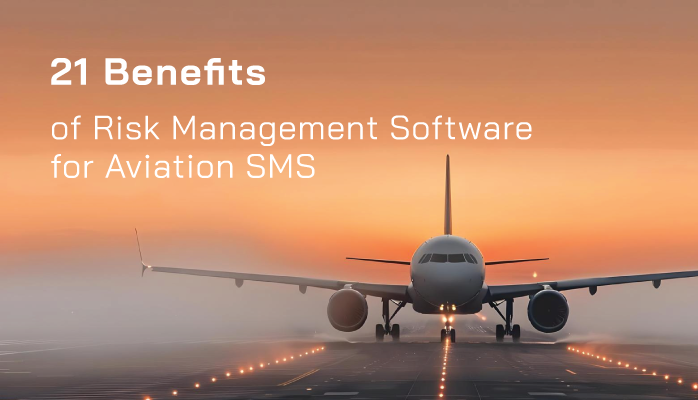Oversight Agencies Need to Support Risk Management Software

Something we hear about all the time is the general lack of support from regulatory oversight agencies during inspections and audits. This lack of support that safety managers complain about regards the usage of risk management software in audits that aviation service providers use daily to manage their required safety management systems (SMS).
I don't mean to imply that agencies like the FAA, Transport Canada, or EASA are against operators using risk management software by any means, but during audits and inspections, safety inspectors are often unwilling to determine an operator's SMS compliance by logging in and verifying compliance with the service provider's risk management software. These recalcitrant safety inspectors still adhere to the old way of doing things, such as:
- Printed reports;
- Extensive interviews;
- Binders filled with historical SMS documentation activities; and
- Original paper documentation.
Requiring reams of paper-based reports puts significantly more stress and work on aviation service providers to demonstrate SMS compliance. Safety personnel have enough to do without worrying about transferring a significant amount of data from a computer to a paper-stuffed binder. In short, the demands of many safety inspectors contribute to inefficiencies meant to be solved by modern technology.
Related Aviation Safety Software Articles
- How to Choose Aviation SMS Software - Educating SMS Professionals
- How Does Aviation Safety Software Improve Safety?
- Spreadsheets vs Software for Aviation Safety Management
SMS Auditors' Support for Electronic Record-Keeping Systems
Not all safety inspectors refuse to review an operator's SMS documentation through their risk management software. As I recall the complaints from safety managers, there seems to be a recurring profile for these recalcitrant safety inspectors. In every case I've heard of, these inspectors are:
- Male;
- Over 55 years old; and
- Have more than 20 years in the aviation industry.
I've concluded that safety inspectors refuse to review an operator's risk management software due to:
- Inspector's unfamiliarity with computers or online Web applications; or
- The inspector is in a rush and simply wants simple answers without having to search for the answers.
Yet computer illiteracy is not the only reason safety inspectors don't like to review risk management software during SMS audits. Consider the second reason:
This reason stems from the formal training safety inspectors receive. A couple of years ago, I had the opportunity to discuss this topic with an FAA instructor who trains safety inspectors. This instructor told me that inspectors are trained to look for specific items. Examples of these "specific items" are provided to the inspectors during training. When safety inspectors are in the field conducting their inspections, they are looking for SMS documentation that closely mirrors their training examples. When they are unable to find what they are looking for, inspectors will issue an audit finding, audit concern, or request more information.
In this second scenario, safety inspectors don't have the patience to wade through an unfamiliar software program. Safety inspectors would rather have a simple paper-based report to demonstrate what is expected from the audit or inspection checklist. It is easier for safety inspectors to see the paper, and, naturally, they will resist when they are expected to audit an unfamiliar area, which for them, is the SMS documentation sitting in risk management software in which they are not proficient.
Why SMS Auditors Prefer Paper to Demonstrate SMS Compliance

Unfortunately, this lack of support from safety inspectors unofficially urges operators to continue using their manual SMS documentation strategies, although they are severely inefficient. Alternatively, safety managers will spend days printing and organizing documentation each time an auditor visits. This is too bad because SMS software can significantly benefit any organization and one of the benefits of having SMS documentation requirements be managed electronically is to avoid wasting reams of paper that safety inspectors may merely glance at and end up tossing into the trash.
I believe oversight agencies need to adopt a policy of working with whatever document management strategy a service provider's aviation SMS relies upon. I can see where an inspector may resist in the case of woefully inadequate SMS documentation strategies. However, where an operator uses an organized, electronic record-keeping system to manage SMS documentation requirements, I believe safety inspectors should respect an operator's efforts to adopt modern technologies to manage an aviation SMS' vast documentation requirements.
Modern, web-based aviation risk management software was designed to easily manage and document risk management activities. Furthermore, risk management software usually delivers reports in real-time, thereby offering safety inspectors a real-time view into the operator's SMS.
Related Aviation Safety Software Articles
- How to Perform Risk Assessments without Aviation Risk Management Software
- 20 Benefits of Aviation SMS Software
- How to Choose the Best Aviation Safety Database Software
Below are 20 benefits of safety management software.
Safety Benefits of Risk Management Software
The safety benefits of risk management software are the first and most obvious benefits we think of. While there are significantly more safety benefits than those listed below, the following five benefits are big ones to consider when adopting risk management software:
- Improved data mining (reduced time and increased accuracy);
- More complex/thorough risk analysis to increase organizational effectiveness;
- Improved safety reporting culture (more ways for stakeholders to report safety concerns);
- Significantly more risk analysis options offering multiple perspectives (i.e., computer assistance); and
- Improved fact-based decision-making ability, such as creating higher-quality corrective actions.
One of the primary ways software improved safety so much is that software utilizes an aviation safety database. This database stores information and allows a computer to perform complex operations on data rather than having to manually collate spreadsheets, apply filters, and create final reports. The computer’s ability to do this is, obviously, leaps and bounds ahead of a human managing multiple spreadsheets and paper-based forms.
Financial Benefits of Aviation SMS Software

The financial benefits of safety software are a big deal and not to be easily discounted. Not necessarily because it cuts down on costs (which it does), but because oftentimes, upper management personnel responsible for safety budgets fail to understand that SMS software saves the organization money. They just see SMS software as another expense. To the bean counters, cheaper often means "more aligned to management's objectives of satisfying shareholders."
The financial benefits of using SMS software are significant, and they increase as the size of a company increases. Modern, full-featured risk management software increases the effectiveness of the safety department. See this SMS return on investment study for more information – however here are several financial benefits of safety software:
- Less skilled manpower needed to manage SMS documentation requirements, such as data entry, generating managerial safety performance reports, etc.;
- Increased capability to document safety activities in a collaborative, team environment, thereby saving managers' precious time and increasing convenience, thereby reducing turnover;
- Improved report generating ability (i.e. charts, data presentation) to show to all stakeholders, such as investors;
- Better safety performance increases return on investment for the SMS, such as fewer fines and fewer accidents; and
- Improved managerial oversight and fact-based decision-making ability allow for much less wasted time/money.
Oftentimes, gaining support from upper management means speaking their language: money. If you can demonstrate financial incentives, they are usually much more willing to hear what you have to say.
Related Articles on Aviation SMS Software Budgets
- Why Money Is More Important Than Safety in Aviation Safety Cultures
- How Money Shapes Safety Culture in Aviation SMS
- How to Manage Aviation SMS Budget Expectations - for Safety Managers
Quality Management Benefits of Aviation SMS Software
Quality management is safety management’s twin sister. Their operations are tightly intertwined and they both share common elements. In many organizations, things like safety training and auditing are handled outside the safety department, such as by the organization's training department and quality assurance department. Aviation SMS software can be a valuable ally to them as well.
- Delivering and documenting automated safety training reduces training time and costs;
- More thorough audit preparation;
- Better audit performance;
- Much less burden to implement an integrated quality-safety management system; and
- Better productivity for all operations, as manual work in regard to SMS documentation is mostly eliminated.
Aviation SMS software naturally has quality management system functionality built into it because aviation SMS concepts originate from quality management systems. Aviation SMS software is designed around core risk management logic and workflows, and so naturally compliments quality management operations in reducing risk and improving operational integrity.
Administrative Benefits of Safety Management
Something that most organizations fail to grasp when they move from a manual SMS data management strategy to software-based SMS data management is how much easier their lives will be at work. The automated nature of the aviation safety database and software significantly reduces redundant, manual administrative work.
In short, it frees up a lot of time for safety management teams to actually do their job rather than spend time documenting what they are doing. Some of these administrative benefits are:
- Better organizational abilities;
- Significantly less administrative data entry burden;
- Better data security against loss and unauthorized access;
- Significantly better data authorization ability, including improved data protection capabilities; and
- More safety resources – and easier access to those resources – for employees to build a safety culture.
Related Aviation Safety Culture Articles
- What Is Safety Culture in Aviation Risk Management
- How to Build Safety Culture in Aviation SMS
- What Does Aviation Safety Culture Look Like?
Final Thought: One Last Major Benefit
One last benefit you probably haven’t thought of is this:
- Amazing future potential of the software.
The digital age has only just begun, and there is no better time to get on board with SMS software than now. We can only guess at the future potential of safety management software. A software program might very well:
- Communicate with aircraft and automatically generate safety reports; or
- Use complex algorithms to perform predictive analysis with degrees of accuracy we never thought possible.
The potential is very great, and using software now means getting started storing all safety data in a digital format. With manual programs, the ceiling is human ability. SMS software doesn’t seem to have a limit at this point in time.
For a live demonstration of safety management software, please see these short demo videos below.
Last updated in May 2025.







